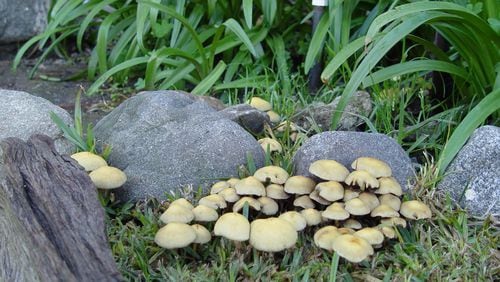I discovered fungi in the coastal forests of Northern California. There I came to recognize the mushrooms, lichens and liverworts, all small primitive plants you might not notice. What makes fungi different is they cannot photosynthesize like green plants because they lack chlorophyll. That’s why edible mushrooms are cultivated in darkness.
Due to the primitive nature of fungi, it’s doubtful any will be affected by serious climate change. They have proven immense adaptability and will survive if sunlight is minimized. All have evolved through cataclysmic changes in the earth’s surface over millions of years and remain relatively unchanged to this very day.
Everyone should understand the life cycle of fungi so you know what to do when you encounter it in a nursery pot, potting soil or natural soil. Fungi are primary decomposers, and on the coast they are still breaking down the remnant stumps of first growth redwoods. Though terrestrial fungi grow in the soil, they are feeding off woody matter underground. Fungi are always plentiful in soils or where there is a lot of decomposing litter and old dead trees with plenty of rainfall.
The body of these fungi is called mycelium, (my-see-lee-um) which looks like a giant spider’s web of fibers called hyphae growing through organic matter or soils. This is the actual functioning plant.
When the fungus organism reproduces, it “flowers” by forming mushrooms. They’re not real flowers, but spore-bearing structures called “fruiting bodies.” They form, mature and then open to release microscopic spores into their environment. Spores are so lightweight that many fungi are global plants, spores traveling on high altitude winds to every continent.
With this knowledge you’ll understand fairy rings in the lawn or forest a lot better. These rings were first credited to folklore’s forest fairies and are common examples of reproducing fungi.
That fairy ring fungus species began life at the center of the ring underground, perhaps introduced within a bit of wood. This mycelia grows outward from the center point symmetrically into a perfect circle. When it reaches the optimal stage and season, mushrooms pop up at the outer edges of the underground mycelium. Removing the mushrooms only interrupts reproduction, but does nothing to discourage the larger organism underground. It will pop up again when the time is right.
Another common fungal source is potting soil. Planting mixes in bags or in container plants include woody matter that contains forest fungi. Some of it is quite chunky. Add moisture from irrigation combined with the shade of the plant above and you’ll see fruiting bodies appear from the mycelia inside. The fungus is not necessarily detrimental to the plants, just a nuisance that vanishes with sunnier, drier days.
Fungus often follows fill material or topsoil integrated with woody matter. It also results from putting fill over woody trash that will start decomposing immediately after burial. They may also appear in association with manures mixed with wood shaving stall bedding. After the first rain year, the whole area could pop up in fruiting bodies.
It’s best to consider all mushrooms deadly poison to pets, livestock and of course, kids. For that reason promptly pick and discard in the garbage can to keep your lawn and garden safe.
Fruiting bodies are diverse from huge puff balls the size of a softball to delicate psychedelic psilocybin and the famous red and white amanita linked to Santa Claus legends in Scandinavia. Learning to recognize their differences is a rewarding way to observe details in dark dank forests where these beauties dwell.
The world of fungi can make you a really fun guy if you take the kids fungus hunting this winter. Where it’s too cold, just wait for spring rains and start walking. Then when you find that perfectly beautiful fruiting body, photograph and post online to share your newfound discovery of what you don’t see underground.
———
Maureen Gilmer is an author, horticulturist and landscape designer. Learn more at www.MoPlants.com






